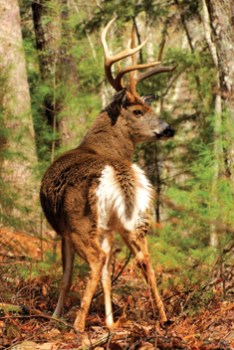East Tennessee Outdoors
Published 12:56 pm Thursday, April 2, 2020
1 of 2
Buck Talk – Part 2
The whitetail doe did not know I was in the world as she slipped through the cliffs in front of my tree stand. I could take her, and she would be delicious with a few potatoes, carrots and cornbread, but I chose to let her walk away because of her body language.
She would walk a few steps, stop and look back. Also, her tail was hanging to one side – signs she had a boyfriend following her, waiting on her to be receptive to his advances.
I watched and waited. Soon her boyfriend, a nice little five-point buck came through the same cliffs with his head to the ground. He was in love and was ignoring everything around him.
The two deer walked out of sight of my stand, then suddenly the doe turned back and walked under my stand. She stopped, but I just waited.
A few minutes later the buck that had been following her stopped under my stand and offered me a shot that was too good not to take. He was a young deer and his meat was delicious.
I wish I had a dollar for every time a buck’s or doe’s body language has helped a hunter be successful. While most deer make excellent use of their nose, ears, and eyes, being able to understand a buck’s body language can help us to even the game.
Body language can tell you if the deer is scared or has been spooked by some predator. It can tell us if they are looking for love, whether they are content, and which deer is the dominant deer in a herd.
Last time in this column we discussed three things a deer’s body language may say, and today we are going to discuss three more.
4. A Deer Has Both Ears Sticking Straight Out
This language is showing the rest of the deer that this buck or doe is the dominant deer in the herd.
It may be a large buck who sticks his ears out to other bucks to tell them he is in charge and to leave the does in the herd alone. It can also be used by an Alpha Doe who is an older deer and is larger than most of the other deer.
We have all seen her. She is the one with the large neck and will be very watchful. Be careful around these Alpha Does.
They will often see you move and warn the herd long before any buck does.
5. A Buck or Doe Rotate Their Ears
If you see a buck or doe rotate its ears, they are suspicious and are listening to all of the sounds in the forest.
If you are hunting and see this trait, freeze. One sound can spook the deer.
Deer are more likely to do this during a windy day because of so much noise in the woods. They will rotate their ears to try to identify these noises.
If it is windy out, try stalking and moving as the wind blows. He may think you are a squirrel or a group of leaves blowing along the forest floor.
6. A Buck Deer Flares Its Tail
If you see a buck looking in a direction and flaring the hairs on its tail and butt, he has sensed danger and is getting ready to sound the alarm whistle.
If you follow a deer’s eyes, sometimes you will see coyotes, bobcats or even other hunters when they do this.
This may be a good time to shoot because the odds are not in your favor. That buck is getting ready to find a more secure place.
I love to go to the mountains and study deer. They are fascinating animals and have their own unique language.
I have learned that the more I know about them, the more successful I am when I hunt them. They just show that every living creature has a language of its own.







